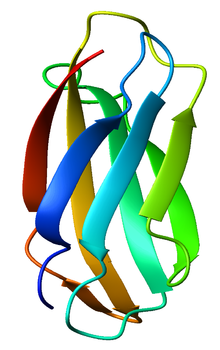
Tenascin
Encyclopedia

Extracellular matrix
In biology, the extracellular matrix is the extracellular part of animal tissue that usually provides structural support to the animal cells in addition to performing various other important functions. The extracellular matrix is the defining feature of connective tissue in animals.Extracellular...
glycoproteins. They are abundant in the extracellular matrix of developing vertebrate
Vertebrate
Vertebrates are animals that are members of the subphylum Vertebrata . Vertebrates are the largest group of chordates, with currently about 58,000 species described. Vertebrates include the jawless fishes, bony fishes, sharks and rays, amphibians, reptiles, mammals, and birds...
embryos and they reappear around healing wounds and in the stroma
Stroma (animal tissue)
In animal tissue, stroma refers to the connective, supportive framework of a biological cell, tissue, or organ.The stroma in animal tissue is contrasted with the parenchyma.Examples include:* Stroma of iris...
of some tumors.
Types
There are four members of the tenascin gene family: tenascin-C, tenascin-R, tenascin-X and tenascin-W.- Tenascin-CTenascin CTenascin is a protein that in humans is encoded by the TNC gene.-Interactions:Tenascin C has been shown to interact with fibronectin.-Further reading:...
is the founding member of the gene family. In the embryo it is made by migrating cells like the neural crestNeural crestNeural crest cells are a transient, multipotent, migratory cell population unique to vertebrates that gives rise to a diverse cell lineage including melanocytes, craniofacial cartilage and bone, smooth muscle, peripheral and enteric neurons and glia....
; it is also abundant in developing tendons, boneBoneBones are rigid organs that constitute part of the endoskeleton of vertebrates. They support, and protect the various organs of the body, produce red and white blood cells and store minerals. Bone tissue is a type of dense connective tissue...
and cartilageCartilageCartilage is a flexible connective tissue found in many areas in the bodies of humans and other animals, including the joints between bones, the rib cage, the ear, the nose, the elbow, the knee, the ankle, the bronchial tubes and the intervertebral discs...
. - Tenascin-RTenascin-RTenascin-R is a protein that in humans is encoded by the TNR gene.- Function :Tenascin-R is an extracellular matrix protein expressed primarily in the central nervous system. It is a member of the tenascin gene family, which includes at least 3 genes in mammals: TNC , TNX , and TNR...
is found in the developing and adult nervous system. - Tenascin-X is found primarily in loose connective tissue; mutations in the human tenascin-X gene can lead to a form of Ehlers-Danlos syndromeEhlers-Danlos syndromeEhlers–Danlos syndrome is a group of inherited connective tissue disorders, caused by a defect in the synthesis of collagen . The collagen in connective tissue helps tissues to resist deformation...
. - Tenascin-W is found in the kidneyKidneyThe kidneys, organs with several functions, serve essential regulatory roles in most animals, including vertebrates and some invertebrates. They are essential in the urinary system and also serve homeostatic functions such as the regulation of electrolytes, maintenance of acid–base balance, and...
and in developing bone.
The basic structure is 14 EGF-like repeats towards the N-terminal end, and 8 or more fibronectin
Fibronectin
Fibronectin is a high-molecular weight glycoprotein of the extracellular matrix that binds to membrane-spanning receptor proteins called integrins. In addition to integrins, fibronectin also binds extracellular matrix components such as collagen, fibrin and heparan sulfate proteoglycans...
-III domains which vary upon species and variant.
Tenascin-C isoform is the best understood. It has anti-adhesive properties, causing cells in tissue culture to become rounded after it is added to the medium. One mechanism to explain this may come from its ability to bind to the extracellular matrix glycoprotein fibronectin
Fibronectin
Fibronectin is a high-molecular weight glycoprotein of the extracellular matrix that binds to membrane-spanning receptor proteins called integrins. In addition to integrins, fibronectin also binds extracellular matrix components such as collagen, fibrin and heparan sulfate proteoglycans...
and block fibronectin's interactions with specific syndecans. The expression of tenascin-C in the stroma of certain tumors is associated with a poor prognosis.

